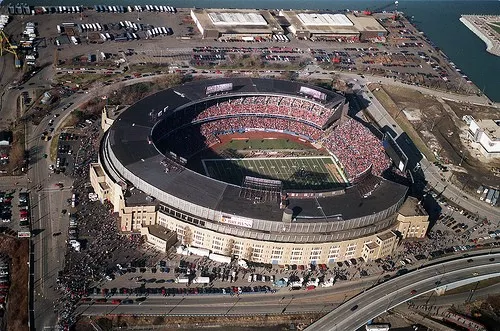A History of Municipal Stadium
When the aging Municipal Stadium was finally demolished in 1996, a part of football history died with it.
This stadium saw many amazing events, including NFL Championships for Cleveland’s beloved Browns.
The history of this stadium is fascinating to examine.
Let’s take a look at the complete history of Cleveland Municipal Stadium from its beginning to end.
The Beginning of the Stadium
In 1928, Cleveland was an expanding city that wanted a high-quality stadium where it could host a variety of different events.
So, as part of a city vote, the town raised a $2.5 million bond that year to build the stadium.
Construction took about three years and, when finished, cost about $3 million.
Adjusted for inflation, that is about $36 million now.
When the stadium was finished, it could hold 78,000 and had the largest outdoor capacity in the world.
The city immediately put the stadium to good use by hosting a heavyweight boxing event on July 3, 1931.
During this fight, Max Schmeling beat Young Stribling to win a championship.
The stadium is also where the Cleveland Indians started to play in 1932 onward and hosted the 1948 and 1954 World Series here.
Football in Cleveland, however, did not show up until 1946 after the Browns were formed in the All-American Football Conference or AAFC.
This league lasted just four years, during which the Browns dominated, winning all four championships and hosting three in Municipal Stadium.
The Dominance of the Browns
The skilled play of the Browns under legendary and innovative coach Paul Brown was fueled by quarterback Otto Graham and a fast, strong, and hard-hitting team.
The failure of the AAFC has been partially blamed on their success, as no other team could compete and interest waned.
The Browns were then added to the NFL in 1950.
The NFL believed that the AAFC was an inferior league that drafted only minor players and didn’t think that the Browns would stand a chance.
In fact, the Browns were scheduled against reigning champs, the Philadelphia Eagles, in their first game.
The gag backfired, as the Browns stomped them 35-10.
They then went on to win their first NFL championship in their first year by beating the Los Angeles Rams 30-28 on a last-minute field goal.
Cleveland went on to win NFL championships in 1952 and 1954, and the last in 1964 with running back Jim Brown.
And as they played, Municipal Stadium became electrified with the fans who would later be memorialized as the Dawg Pound.
The Destruction of the Stadium
Although Municipal Stadium stayed the home of the Cleveland Browns throughout the 1990s, the stadium was getting a bit long in the tooth.
Although dedicated fans, particularly the Dawg Pound, loved the personality and history of the stadium, owner Art Modell was sick of it.
He wanted a new stadium to host the Browns, one that could bring in more fans and more revenue.
However, the city struggled to raise enough money, and Modell himself did not have the capital to build a new one.
Trapped between a rock and a hard place, Modell made his most controversial move in a career littered with them – relocating the team to Baltimore.
Fans were outraged, and the city tried to sue Modell to force him to stay in Cleveland.
The lawsuit was a success, in a rather strange way.
While Modell would be allowed to take the current team with him to Baltimore – where a new stadium was waiting – this team would have a new name, mascot, and records.
The old Browns’ name, mascots, and records would pass to the city itself.
Several years later, a new owner purchased the rights from the city to restart the Browns.
But Municipal Stadium – torn down in 1996 – would not be part of this new part of Browns’ history.
Today, the current Cleveland Browns play in the FirstEnergy Stadium, built on top of the old Municipal Stadium.
The new stadium was built to serve the newly-reestablished Browns squad.
Unlike other stadiums named after a business, the FirstEnergy Stadium belongs to the city: only the naming rights belong to FirstEnergy. Everything about the new stadium is an upgrade from Municipal Stadium.
However, the town’s and the team’s many loyal fans do not perceive the stadium as fondly as the previous one.
Some in the Dawg Pound consider it too clean and antiseptic.
Others don’t appreciate the presence of corporate elements, such as selling the name of the stadium to FirstEnergy.
And since 2011, it has been known as the “Factory of Sadness” due to the Brown’s continued struggle to put together a competitive team.
During a particularly rough period, they went 0-16, just the second team in NFL history to do so.
In spite of this struggle, the memory of Municipal Stadium – and the team’steam’s past successes – inspire fans even now and get them hopeful for future achievements.
NEXT: When Bill Belichick and Nick Saban Coached Together